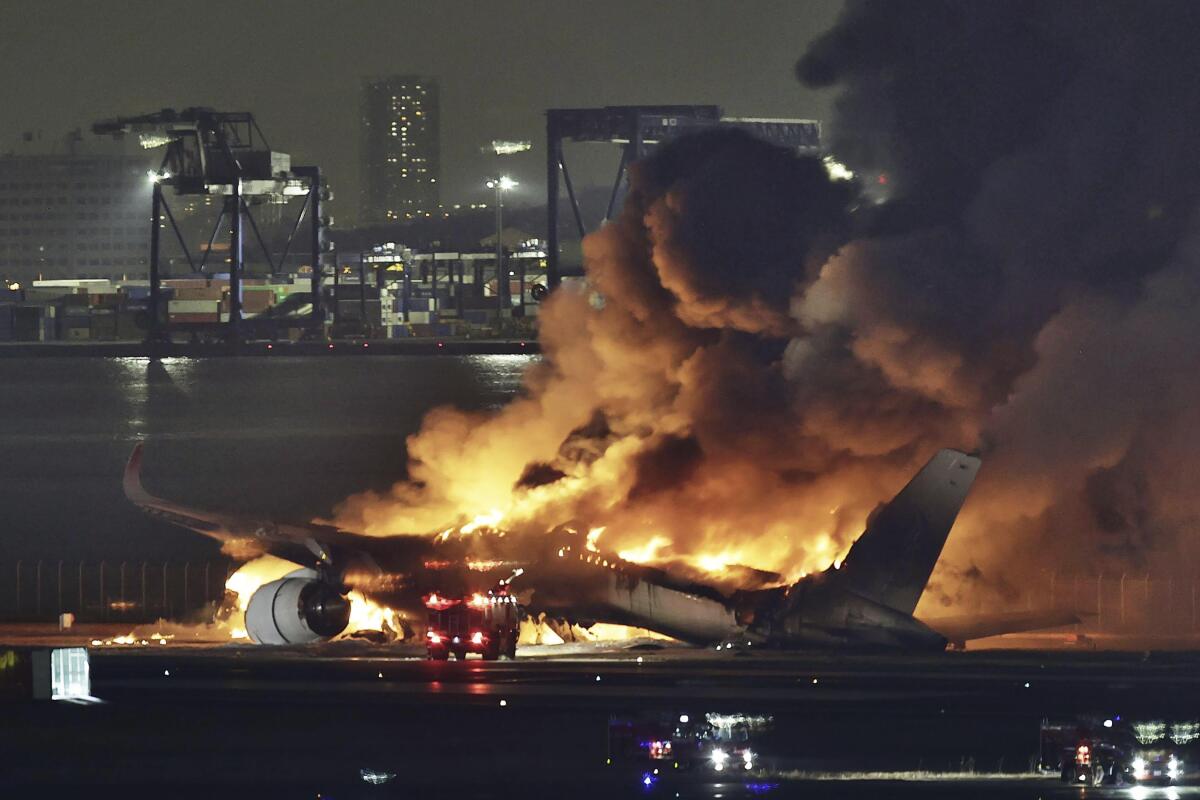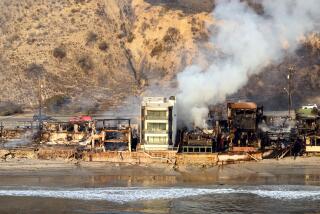A jet’s carbon-composite fiber fuselage burned on a Tokyo runway. Is the material safe?

- Share via
The fuselage of the jetliner involved in a collision on a Tokyo runway was made from carbon-composite fibers, and the incident is renewing concern about the challenges of putting out fires involving the material.
The fire is shaping up as a key test of the safety of composite materials compared with conventional airplane fuselages made of aluminum.
Investigators appear to be focusing immediately on communication between the pilots of both planes and air traffic controllers at Haneda Airport. A transcript released Wednesday indicated that the landing Japan Airlines A350 had permission to use the runway but the Japanese coast guard plane did not.
Safety experts are praising the airline’s crew after everybody was able to escape the burning jetliner. Five people on the coast guard plane were killed.
A passenger plane and a Japanese coast guard aircraft collide on the runway and burst into flames, killing 5 coast guard crew members.
Composites have been used for many years inside commercial planes, such as the floorboards and other structures.
Boeing built the first commercial plane with a fuselage and wings made from composites reinforced with carbon fibers, the 787. The plane went into airline service in 2011, and about 1,100 have been produced.
Airbus followed in 2018 with the A350 — like the 2-year-old plane involved in Tuesday’s collision — and has sold about 570 of them.
“There has always been a concern about composites if they catch fire because the fumes are toxic,” said John Goglia, a former member of the National Transportation Safety Board, which investigates accidents in the United States. “That threat continues as long as the airplane burns — actually after, because those little fibers might be floating around in the smoke.”
“That fuselage protected them from a really horrific fire — it did not burn through for some period of time and let everybody get out,” said safety consultant John Cox. “That is a positive sign.”
Goglia said there is no real-world evidence on whether composite skins are any better or worse than aluminum at resisting fire and heat long enough to give passengers a chance to escape.
Aircraft manufacturers are supposed to show that their planes can be evacuated in 90 seconds with half the exits blocked, although skeptics question the accuracy of U.S. government-run tests.
On Tuesday night, video captured a fireball on the JAL plane as it continued down the runway after the crash.
“The flammability issue is something they have to look at, but obviously nobody [on the jetliner] burned to death,” said aviation attorney Justin Green. “It seems the fuselage and the seats [made of fire-retardant material] and everything else protected the flight crew and the passengers.”
There has long been concern about toxic smoke released when carbon-reinforced composites burn.
As far back as the 1990s, the Federal Aviation Administration said the main health hazards from composites present in plane crashes and fires were sharp splinters from exposed material, fibrous dust, and toxic gases generated from burning resins.
“From early reports, it appears that there was a significant amount of smoke in the cabin, and it is not yet clear if any of the smoke was from burning composites,” said Todd Curtis, a former Boeing engineer who is now a safety consultant.
Curtis said a key follow-up for investigators and regulators will be monitoring whether passengers or firefighters were injured by exposure to toxic smoke from the burning composite.
Those injuries could take a long time to show up, said Steven Marks, an aviation attorney. He said passengers involved in accidents are usually in shock and often don’t immediately recognize the severity of their injuries.
Curtis, the former Boeing engineer, said both in the Haneda crash and a 2013 fire on an Ethiopian Airlines Boeing 787 that was parked at London’s Heathrow Airport, “putting out the fire took much more effort than with a typical airliner fire.”
The official report said the fire at Heathrow started with crossed wires in the plane’s emergency locator transmitter, but added, “The resin in the composite material provided fuel for the fire, allowing a slow-burning fire to become established in the fuselage crown.”
Curtis said that incident made him worry about fuselage fires on the ground and in the air back in 2013, “and these concerns have not gone away.”
More to Read
Sign up for Essential California
The most important California stories and recommendations in your inbox every morning.
You may occasionally receive promotional content from the Los Angeles Times.











